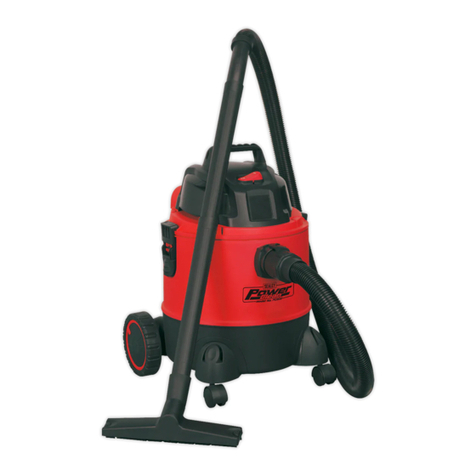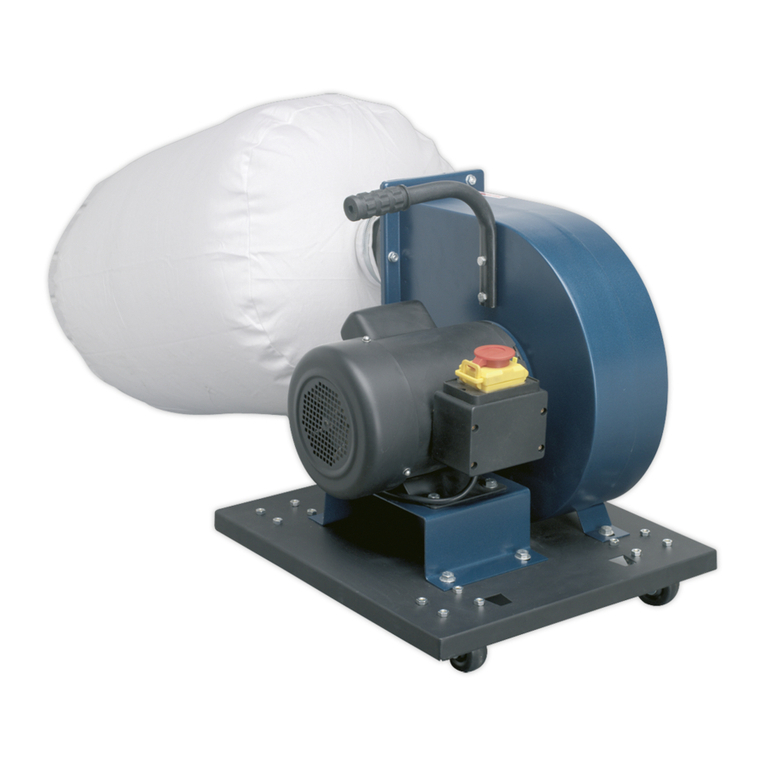Sealey CPV144.V2 User manual

INSTRUCTIONS FOR:
CORDLESS WET/DRY
RECHARGEABLE VAC
MODEL No: CPV144.V2
1. SAFETY INSTRUCTIONS
IMPORTANT: PLEASE READ THESE INSTRUCTIONS CAREFULLY. NOTE THE SAFE OPERATIONAL REQUIREMENTS,
WARNINGS AND CAUTIONS. USE THIS PRODUCT CORRECTLY AND WITH CARE FOR THE PURPOSE FOR WHICH IT IS
INTENDED. FAILURE TO DO SO MAY CAUSE DAMAGE AND/OR PERSONAL INJURY AND WILL INVALIDATE THE WARRANTY.
KEEP THESE INSTRUCTIONS FOR FUTURE USE.
Thank you for purchasing a Sealey product. Manufactured to a high standard this product will, if used according to these instructions and properly
maintained, give you years of trouble free performance.
1.1. GENERAL
Keep the vac clean and in good condition.
Replace or repair damaged parts. Use recommended
parts only. Unauthorised parts may be dangerous and
will invalidate the warranty.
Keep children and non-essential persons away from the
work area.
DO NOT leave the vac operating unattended.
DO NOT use the vac for a task it is not designed for.
DO NOT operate the vac when you are tired or under
the influence of alcohol, drugs or intoxicating medication.
DO NOT operate the vac if any parts are missing or
damaged, as this may cause failure and/or personal
injury.
Stay alert, watch what you are doing and use common
sense when operating vac.
Do not allow persons unfamiliar with the vac or these
instructions to operate the vac.
Ensure the switch is in the off position before inserting
battery pack.
Recharge only with the charger supplied.
Use vac only with specifically designated battery packs.
WARNING! Under extreme conditions, liquid may be
ejected from the battery: avoid contact. If contact
accidentally occurs, flush with water. If liquid contacts
eyes, also seek medical help.
WARNING! Sparks inside motor can ignite flammable
vapours or dust. To avoid fire or explosion do not use
near flammable or combustible liquids or gases.
DO NOT vacuum anything that is burning or smoking
such as cigarettes, matches or hot ashes.
DO NOT vacuum toxic materials to avoid health hazards
from vapours or dusts.
Keep the vac and all accessories where they will not be
subjected to heat or flame. To avoid injury, shock, or fire,
never use a damaged vac, cord or charger.
DO NOT put any object into openings.
DO NOT use with any opening blocked.
Keep free of dust, lint, hair, and anything that may
reduce air flow. Keep hair, loose clothing, fingers away
from openings and moving parts.
DO NOT use for dry vacuuming without filter in place.
DO NOTuse any charger other than the one with the vac.
DO NOT handle plug or charging unit with wet hands.
Replace or repair damaged parts. Use recommended
parts only. Unauthorised parts may be dangerous and
will invalidate the warranty.
1.2. BATTERY SAFETY
BATTERIES MAY BE DANGEROUS IF NOT HANDLED
WITH CARE AND ACCORDING TO THESE
INSTRUCTIONS.
Before removing battery from charger or vac, remove
personal metallic items such as rings, bracelets,
necklaces and watches.
Ensure the charger is switched off and disconnected
before attempting to remove the battery.
If the battery terminals are corroded or dirty, clean
them before replacing battery.
DO NOT dis-assemble the battery for any reason.
WARNING! DO NOT allow metal objects to touch both
battery terminals simultaneously. Arcing or short circuit
will result.
DO NOT allow battery terminals to make contact with
any other metallic part.
DO NOT leave battery in a discharged state, recharge
battery immediately. If the vac is not in use, recharge the
battery every three months.
Dispose of the old battery in accordance with local
authority acid battery regulations. DO NOT dispose of
with regular refuse.
1.3. ELECTRICAL SAFETY
USE ONLY SUPPLIED CHARGER PLUG FOR VAC.
WARNING! It is the user’s responsibility to read, under
stand and comply with the following electrical
instructions: You must ensure the risk of electric shock is
minimised by the installation of appropriate safety
devices. An RCCB (Residual Current Circuit Breaker
should be incorporated in the main distribution board.
We also recommend that an RCD (Residual Current
Device) is used with all electrical products, particularly
portable equipment which is plugged into an electrical
supply not protected by an RCCB.
You must also read and understand the following
instructions concerning electrical safety.
1.3.1. The Electricity At Work Act 1989 requires all portable
electrical appliances, if used on business premises, to
be tested by a qualified electrician, using a Portable
Appliance Tester (PAT), at least once a year.
1.3.2. The Health & Safety at Work Act 1974 makes owners
of electrical appliances responsible for the safe condition
of the appliance and the safety of the appliance operator.
If in any doubt about electrical safety, contact a
qualified electrician.
1.3.3. You must ensure that you:
Inspect the charger plug, cable and connector for wear
and damage to ensure items are safe before connecting
to the mains power supply. If worn or damaged DO NOT
use.
Check cables are always protected against short circuit
and overload.
Important: Check that the voltage marked on the charger
plug is the same as the power supply to be used.
Uncoil the cable between charger and the charger base.
DO NOT pull the charger plug from the mains socket by
the lead.
DO NOT use any other type of charger with this product.
DO NOT try to take the charger plug apart.
DO NOT use the charger plug to charge or power any
other electrical item.
DO NOT get charger wet, or use in wet, damp conditions
(for indoor use only).
Original Language Version CPV144.V2 Issue: 3 - 17/01/12

2. SPECIFICATIONS
Ideal for quick clearing up of spillage. Convenient for use in
the home, workshop or car. Supplied with crevice tool.
Features removable collection chamber for easy disposal of
waste and removable battery with base charger.
Voltage:............................ 14.4V
Charging Time: ................. 3-5hr
Weight: .............................1.6kg
3. OPERATION
IMPORTANT WARRANTY INFORMATION:
The battery pack fitted to this cordless tool is
considered to be a consumable item and its ability to
accept charge will reduce over time. We will warranty
it against mechanical and electrical defect for a period
of one year - this does not cover fair wear and tear. If
the battery is not properly charged before first use, or
regularly conditioned, its capacity will diminish. Under
these circumstances we will not replace the battery
pack even if it is less than one year old.
3.1 CHARGING BATTERY PACK
WARNING! Ensure you read and understand safety
instructions before use.
3.1.1 Ensure your supply corresponds with the voltage
rating of the charger, 230V 50Hz AC only.
3.1.2 Connect the charger plug to the power supply. Plug
the lead from the charger plug into the charger stand.
3.1.3 Insert the battery pack into the charge stand. Align
the raised rib on battery pack with groove in the
charging stand (fig.1). As the pack is inserted into the
stand the red charging light will come on.
3.1.4 Press lightly down on the battery pack to ensure the
contacts on the battery pack engage properly with
the contacts in charging stand.
3.1.5 Charging time is 3 - 5 hours. The red charging light
will remain on until the battery pack is removed from
the charging stand or the charger is disconnected
from the supply.
Note: The battery pack will become slightly warm to the
touch while charging. This is normal and does not
indicate a problem.
3.1.6 The battery pack will only go into the main body one
way round. Hold the battery pack with the neck
towards the bottom of the pack and insert it into the
back of the main body. Push the battery home until it
snaps into place.
IMPORTANT! When using your vac continuously, the
batteries will become very hot. You should let a hot
battery pack cool down for approximately 30 minutes
before attempting to recharge.
3.2 TO VACUUM DRY SPILLS, DUST AND DIRT
q Warning. When dry vacuuming, the filter must be
attached to the inner baffle moulding. Failure to
do this will result in debris entering the motor
compartment causing damage to the motor and
invalidating your warranty.
3.2.1 If required attach the crevice tool to the dust collector
by pushing it into the front opening as indicated in
fig.7.
3.2.2 Slide the ON/OFF switch forwards (fig 2) and proceed
to vacuum.
3.2.3 Upon completion of vacuuming slide the On/Off switch
back to the OFF position.
3.2.4 To empty the dust collector, position the vac over a
suitable waste receptacle with the dust collector
pointing downward by 45°.
Original Language Version CPV144.V2 Issue: 3 - 17/01/12
3.2.5 Press down on the release button (fig.3-1) and release
the dust collector carefully to avoid spilling the
contents.
3.2.6 Remove the filter and inner baffle from the dust
collector (fig.4).
3.2.7 Tip the dust collector contents into the waste
receptacle. The dust collector may be rinsed in warm
soapy water but must be dried thoroughly before use.
3.2.8 The filter moulding is attached to the baffle moulding
with four keyholes positioned north, south, east and
west. Remove the filter from the inner baffle using a
rotational movement as indicated in fig.5. Hold the inner
baffle with one hand and turn the filter moulding clock
wise using the rib across the filter moulding aperture.
Apply pressure to the points indicated by the two white
arrows in fig.5. To clean the filter, shake the dirt out
over a suitable waste receptacle. Do not scrub the
filter material. If necessary reverse flush the filter by
holding it under a flow of warm water and dry
thoroughly afterwards. This will be necessary after
considerable use as the filter will restrict the airflow and
performance of the vac if it becomes blocked.
3.2.9 Re-assemble the vac by firstly re-attaching the filter to
the inner baffle moulding. Place the filter moulding over
the four pins on the baffle and rotate the moulding anti
clockwise to lock it into place. Push the assembly into
the dust collector until it makes contact with the ribs
inside the collector. Reattach the dust collector to the
main vac body as indicated in fig.3. Firstly hook the
projection on the underside of the main body into the
slot in the lower back edge of thecollector (fig.3-4).
Swing the collector upwards so that the top back edge
snaps into place on the catch (fig.3-2).
3.3 TO VACUUM WET SPILLS
q Warning. The vacuum is designed to pick up small
spills of liquid only such as a spilled drink. Any
attempt to vacuum larger quantities of water may
result in water entering the motor compartment
damaging the product and invalidating your
warranty.
3.3.1 For wet vacuuming detach the filter moulding from the
inner baffle as described in section 3.2.8.
3.3.2 The inner baffle has an integral rubber seal around its
outer perimeter. Make sure that the baffle is pressed
fully home into the collector moulding. Reattach the
collector moulding to the main body.
3.3.3 If required attach the crevice tool to the collector by
pushing it into the front opening as indicated in fig.7.
3.3.4 Slide the ON/OFF switch forwards (fig 2) and, holding
the unit with the nose of the collector pointing down
wards at 45°, move slowly over the liquid.
3.3.5 Upon completion of vacuuming slide the On/Off switch
back to the OFF position. Do not turn the unit horizontal
as the small amount of water in the nose will run out of
the collector intake.
3.3.6 Keeping the collector pointing downwards at 45°
release the main body from the collector. Remove the
inner baffle and pour the liquid down a drain or into a
suitable receptacle such as a bucket.
3.3.7 When vacuuming is complete, thoroughly dry every
thing including the inside of the collector and the baffle
moulding.
3.3.8 Re-assemble the vac and store in a dry location out of
reach of children. If the vac is to be stored for a long
period of time remove the battery from the vac and
store in a safe location.
3.3.9 NOTE: Next time the vac is required for dry vacuuming
ensure that the filter is fitted.

g.1 g.2
g.3
g.4 g.5
g.6 g.7
Original Language Version CPV144.V2 Issue: 3 - 17/01/12

NOTE: It is our policy to continually improve products and as such we reserve the right to alter data, specifications and component parts without prior notice.
IMPORTANT: No liability is accepted for incorrect use of this product.
WARRANTY: Guarantee is 12 months from purchase date, proof of which will be required for any claim.
INFORMATION: For a copy of our latest catalogue and promotions call us on 01284 757525 and leave your full name and address, including postcode.
01284 757500
01284 703534
sales@sealey.co.uk
Sole UK Distributor, Sealey Group,
Kempson Way, Suffolk Business Park,
Bury St. Edmunds, Suffolk,
IP32 7AR
www.sealey.co.uk
Web
email
Original Language Version CPV144.V2 Issue: 3 - 17/01/12
Environmental Protection
Recycle unwanted materials instead of disposing of them as waste.
All tools, accessories and packaging should be sorted, taken to a recycle centre and disposed of in a manner which
is compatible with the environment.
When the product is no longer required, it must be disposed of in an environmentally protective way.
Contact your local solid waste authority for recycling information.
Battery Removal
1. To disconnect the battery pack squeeze the two battery release buttons (fig.3) on the side of the pack and
pull away from the vac.
Dispose of batteries according to local authority guidelines.
Under the Waste Batteries and Accumulators Regulations 2009, Jack Sealey Ltd are required to inform potential purchasers
of products containing batteries (as defined within these regulations), that they are registered with Valpak’s registered
compliance scheme.
Jack Sealey Ltd’s Batteries Producer Registration Number (BPRN) is BPRN00705
Other Sealey Vacuum Cleaner manuals

Sealey
Sealey PC20LN User manual
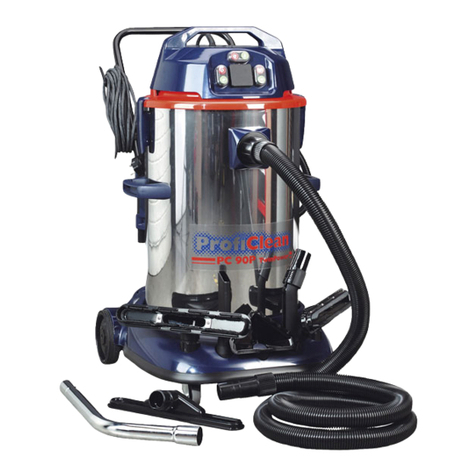
Sealey
Sealey Power Products PC80 User manual

Sealey
Sealey PC300.V2 User manual

Sealey
Sealey CP20VWDV User manual

Sealey
Sealey PC477 User manual
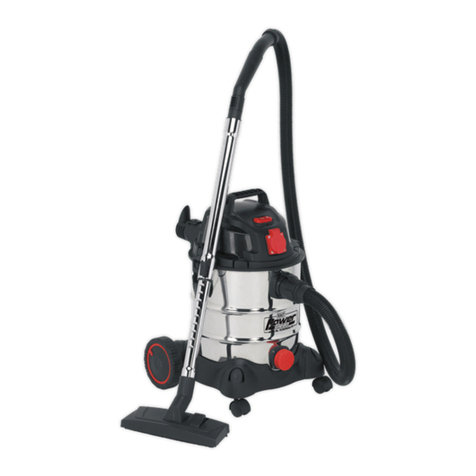
Sealey
Sealey PC200SDAUTO.V3 User manual

Sealey
Sealey PC200SD User manual
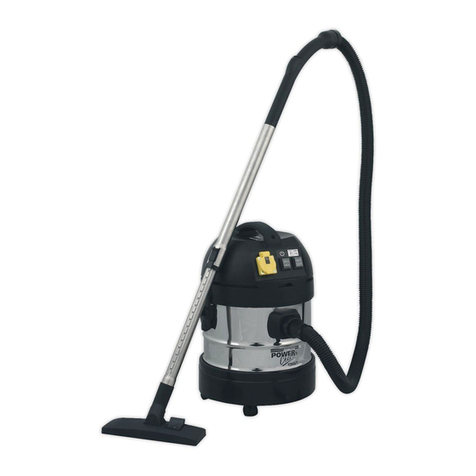
Sealey
Sealey PC200SDAUTO.V2 User manual
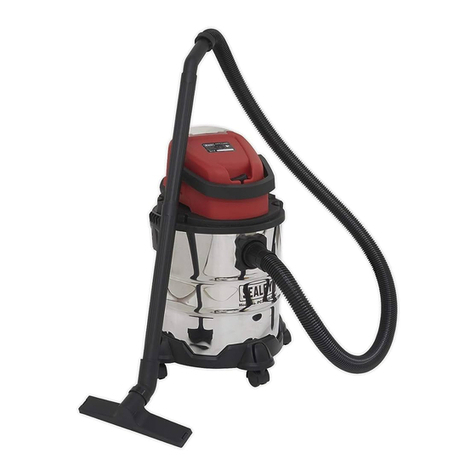
Sealey
Sealey PC20SD20V User manual
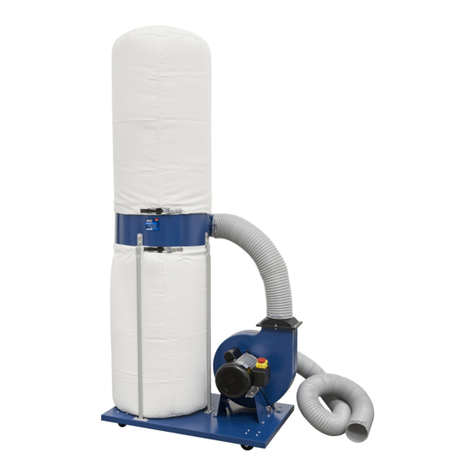
Sealey
Sealey SM47.V3 User manual
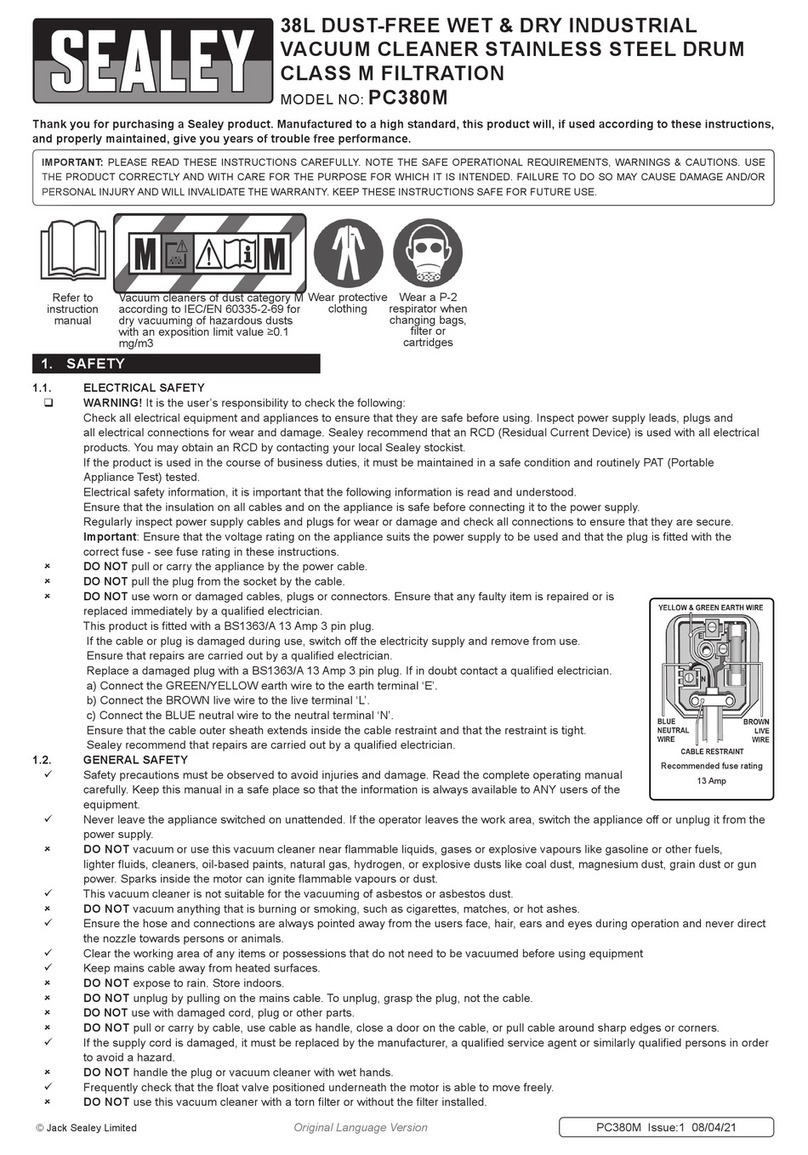
Sealey
Sealey PC380M User manual
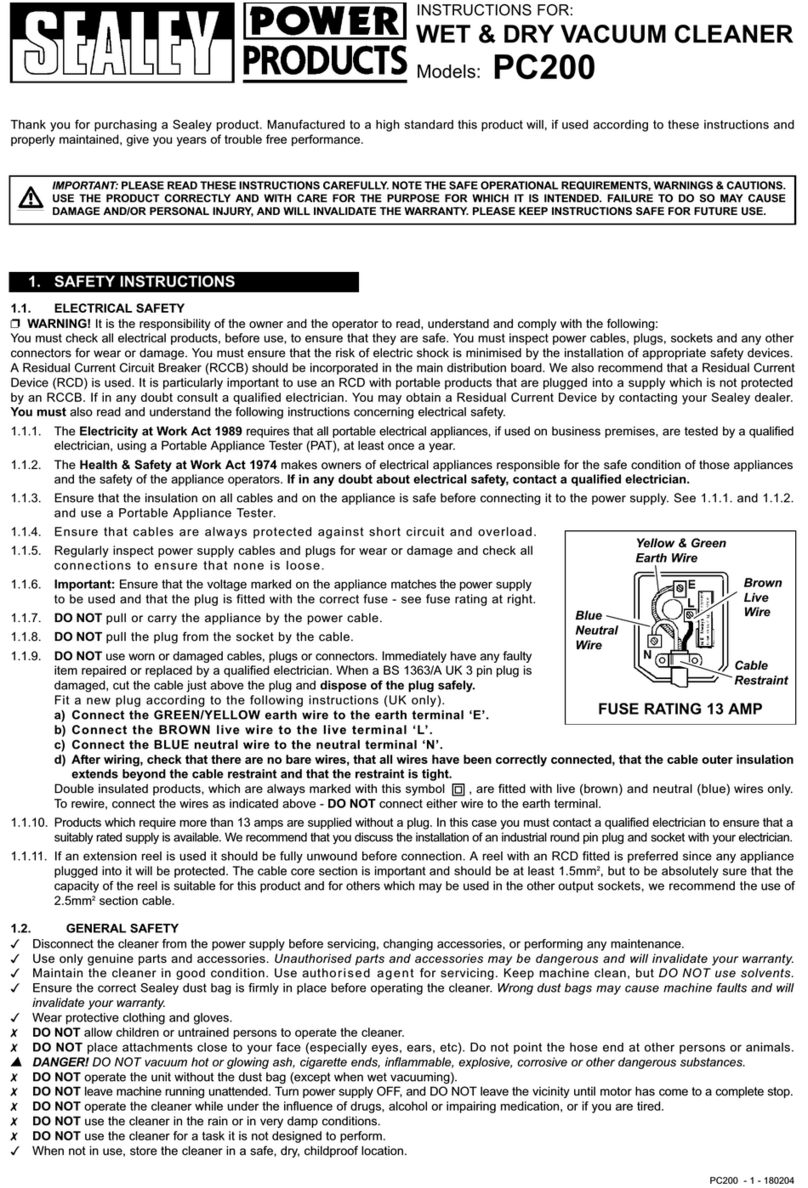
Sealey
Sealey PC200 User manual

Sealey
Sealey CPV144 User manual

Sealey
Sealey PC380M110V User manual

Sealey
Sealey PC35110V User manual

Sealey
Sealey PC300 User manual
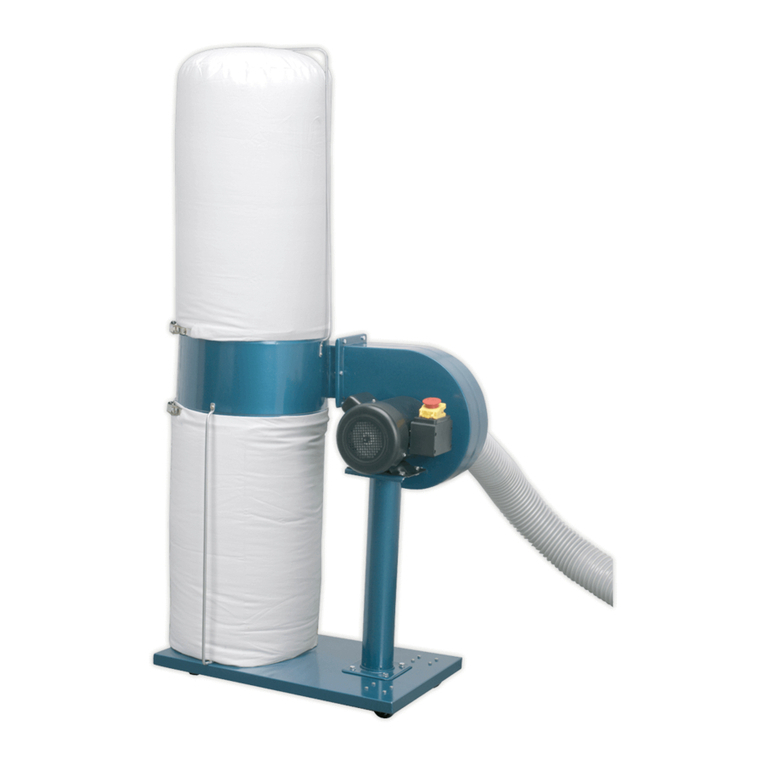
Sealey
Sealey Quality MACHINERY SM46.V3 User manual
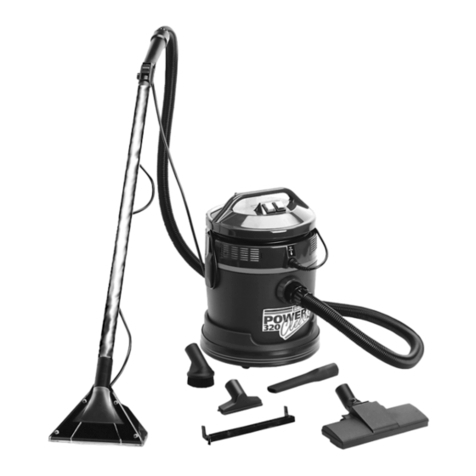
Sealey
Sealey PC320.V2 User manual
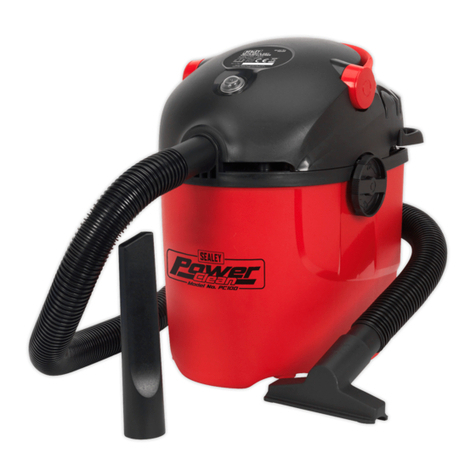
Sealey
Sealey PC100 User manual
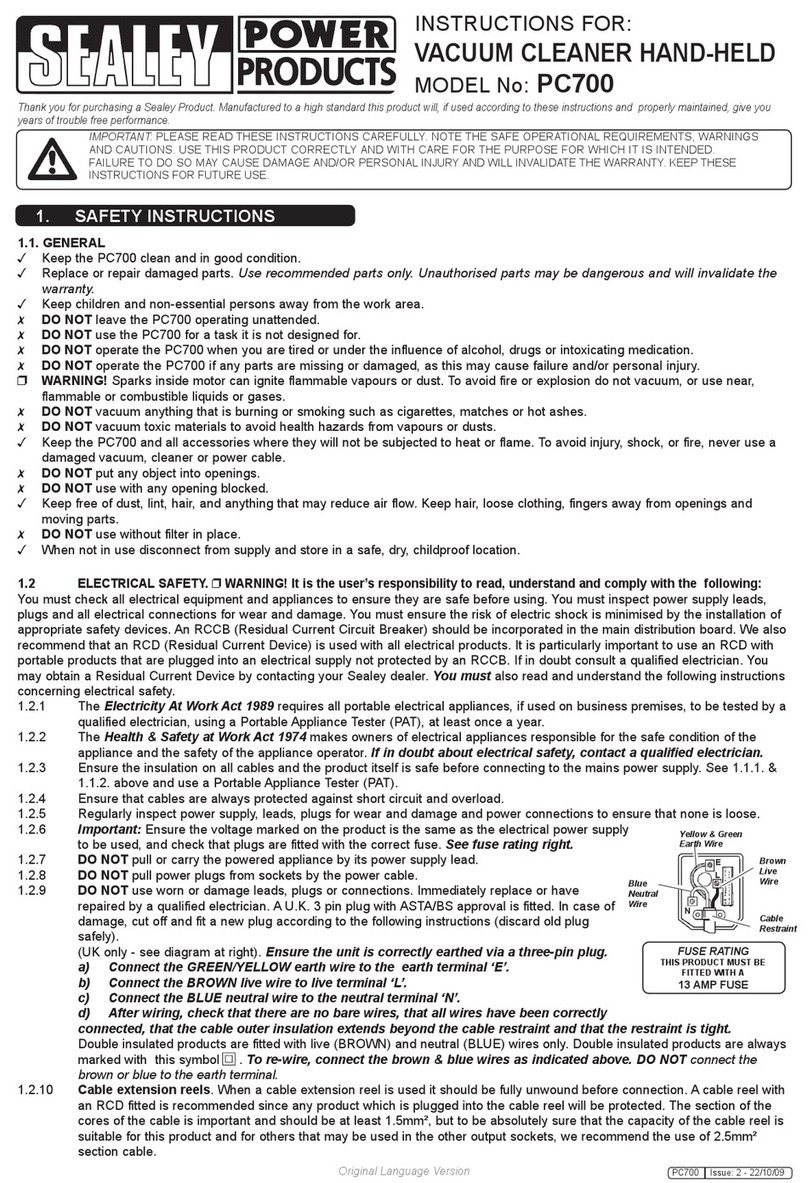
Sealey
Sealey PC700 User manual
